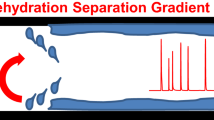Summary
Copolymers from styrene and ethyl methacrylate have been separated according to composition byn-heptane gradients on a C18 bonded phase after injection into acetonitrile and subsequent sudden transition to a concentration of either dichloromethane or tetrahydrofuran between 30 and 50% or 20 and 50%, respectively. Acetonitrile is a polar non-solvent for the copolymers under investigation and ensures proper retention of the samples on a non-polar stationary phase. Dichloromethane and tetrahydrofuran are good solvents of moderate polarity. The addition of, e.g., 30 vol% of one of these solvents increased the dissolution power of the starting eluent but not to the extent necessary for elution. The latter was achieved by the addition ofn-heptane, which is a non-solvent for the polymers investigated. Thus, its eluting power must be understood as the consequence of its modifying effect on the polarity of the eluent mixture. The higher the content of copolymer in ethyl methacrylate the earlier it was eluted. Since acetonitrile andn-heptane are only partly miscible, phase diagrams were measured after the addition of either tetrahydrofuran or dichloromethane as a third component. Homogeneous mixtures were obtained on addition of about 30% solvent (one of both of the latter).
Similar content being viewed by others
References
G. Glöckner, M. Stickler, W. Wunderlich, Fresenius Z. Anal. Chem.328, 76 (1987).
D. Wolf, Thesis, Universität des Saarlandes, 1994.
S. Mori, M. Mouri Analyt. Chem.61, 2171 (1989).
G. Glöckner, D. Wolf, H. Engelhardt, Chromatographia38, 559 (1994).
G. Glöckner, J. Chromatogr.403, 280 (1987).
G. Glöckner, M. Stickler, W. Wunderlich, Fresenius Z. Anal. Chem.330, 46 (1988).
G. Glöckner, Gradient HPLC of Copolymers and Chromatographic Cross-Fractionation, Springer-Verlag Heidelberg (1991), Chapter 5.6.
G. Glöckner, Chromatographia37, 7 (1993).
G. Glöckner, Ref. [7], p. 103.
G. Glöckner, D. Wolf, H. Engelhardt, Chromatographia38, 749 (1994).
L. R. Snyder, J. Chromatogr.92, 223 (1974).
L. R. Snyder, J. J. Kirkland, Introduction to Modern Liquid Chromatography, 2nd edition, John Wiley & Sons, Inc. New York (1979), Table 6.1.
L. Rohrschneider, Analyt. Chem.45, 1241 (1973).
G. Glöckner, Ref. [7], Chapter 11.10.
Author information
Authors and Affiliations
Additional information
Part 3: see Ref. [10]
Rights and permissions
About this article
Cite this article
Glöckner, G., Wolf, D. & Engelhardt, H. Control of adsorption and solubility in gradient high performance liquid chromatography. Part 4. Sudden-transition gradient elution of styrene/ethyl methacrylate copolymers in reversed phase mode. Chromatographia 39, 170–174 (1994). https://doi.org/10.1007/BF02274496
Received:
Accepted:
Issue Date:
DOI: https://doi.org/10.1007/BF02274496




